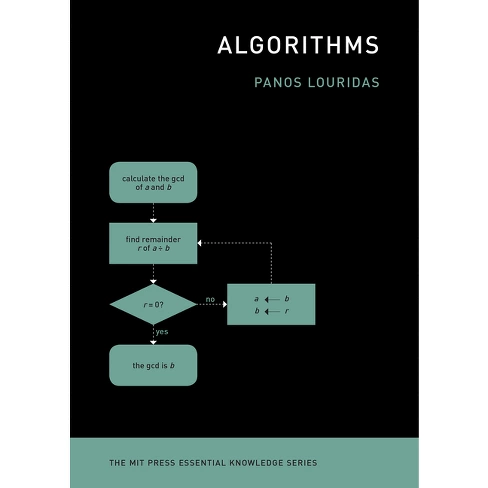
Algorithms (2020) Panos Louridas
This introduction to algorithms is clear and accessible, simply but beautifully written and arranged1. While the style is plain and conversational, arguments and examples are carefully crafted and positioned along the seven chapters of the book, so that readers can follow the author’s explanations all through an expanding quest that progresses from Euclid and al- Khwārizmī to Google’s Larry Page and Sergey Brin, from Euler’s pioneering use of graphs to neural networks.
This vast panorama of scientific and technological development is present from the very beginning of the book, which opens thus: ‘I know two young teenagers who possess more knowledge than any scientist, philosopher or scholar of ages past.’ (Louridas 2020, xi). The teenagers in question (the author’s sons, as it happens), ‘have in their pockets devices that connect them with the vastest repository of information that has ever been created.’ (Ibid., xi)1.
.Neither the devices nor the ‘repository’, of course, could have ever been possible without ‘the huge advances in digital technology’, whose combined effect is glowingly described:
Although we may lose sight of it in the bustle of our everyday lives, we live in the best period of human history. We are healthier than we have ever been, and expect to live longer, on average, than any generation has ever lived. Despite the iniquity of glaring inequality, huge swathes of humanity have gotten rid of the shackles of poverty. We have never been closer to one another, both virtually and literally. We may decry the commercialism of mass global tourism, but cheap travel allows us to experience different cultures and visit places that we could once marvel about on coffee table books. All this progress can and should continue. (Ibid., xii. My italics).
In recent years, algorithms seem to have taken over computers and the Internet as the main agents of such progress. In the so-called ‘Algorithmic Age’ (Ibid., 1-3)
… they [algorithms] are used to organize political campaigns, follow our traces in the online realm, shadow our shopping and target us with advertising, suggest dating partners or monitor our health. (Ibid., 2).
This results, according to the author, in an ‘aura of mystery’ around algorithms that leads, in its turn, to a general feeling of unaccountability; algorithms, then, become ‘a sort of god.’ But they are actually not: An algorithm does not produce its results by an act of revelation. We know exactly the rules that it follows and kinds of steps it takes. No matter how wonderful the outcome, it can always be traced back to some elementary operations. (Ibid., 2). These wide-ranging statements, produced between the Introduction and Chapter 1, do two things for the book. First, they set the general tone for it, one that balances a sense of amazement with the avowed will to disenchant algorithms and show them for what they really are, that is to say, ‘tools that allow us to do certain things well … that allow us to solve problems.’ (Ibid., 3). Second, they effectively suspend almost all consideration of non- technical issues until the very last pages of the book2; whenever they appear before, they mostly do so in the figurative language. For instance, the ranking of web pages is tactfully described as either functioning as a ‘kind of democracy’ (Ibid., 148) or having an ‘aura of democracy’ (Ibid., 153).
One might wonder, at this point, what use such a book can be for the designing of an Aesthetics of Care (AoC). I would argue, counter-intuitively, that there is actually some insight to gain from this work for the AesThiCo project. This insight, though, is not to be found in what is explicitly said in the book, but rather in its rhetoric and imagery (as shown above); also, and most specially, in what the author lefts out of the book. Asking him to treat the technical and non-technical sides of the question on an equal footing might certainly be unfair, but it seems barely possible, in this Algorithmic Age, that an introduction to its foundations does not concern itself, if only for a few pages, with those effects of (technological) progress that surely do not add to a feeling of living ‘in the best period of human history.’
An AoC, then, should be a corrective for such language and ways of thinking, paving the way for an approach to current issues that does not ponder the technical and the non-technical in isolation from each other. When so blatant a statement as ‘We have never been closer to one another, both virtually and literally’ is made, AoC should ask ‘But how close is that closeness that algorithms bring? And do we really care for one another, either virtually or literally, when using or surrendering to algorithms?’
1.Some mathematics is used in the book, as the author considers that ‘you cannot talk seriously about algorithms without some notation’ (Louridas 2020: xvii)
2 The book ends with an Epilogue that is a discussion of a simple Turing machine. Previous themes and opinions are reiterated: ‘… the human intellect has created wonders. The limits of computation have not curtailed our creativity to continue developing algorithms for every aspect of our lives. When writing was invented in Mesopotamia, its purpose was to aid record keeping, not write literature. The first writers were probably accountants, not authors, yet from such humble beginning emerged William Shakespeare. Who knows what, in algorithms will bring.’ (Ibid., 244).
Antonio Fornet Vivancos
Universidad Politécnica de Cartagena
Louridas, Panos. Algorithms. Cambridge (Massachusetts) & London: The MIT Press, 2020.
